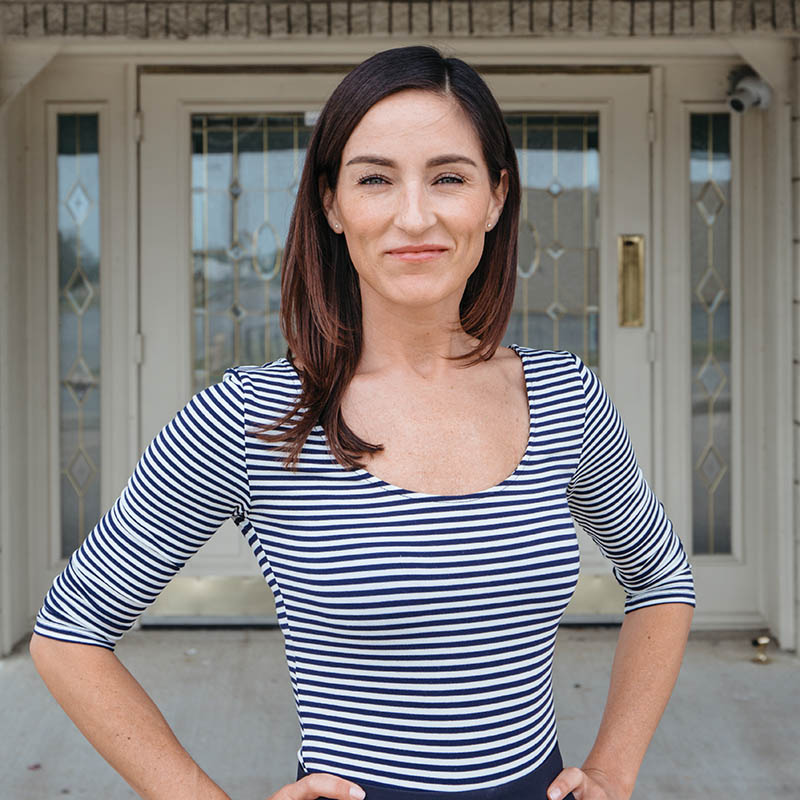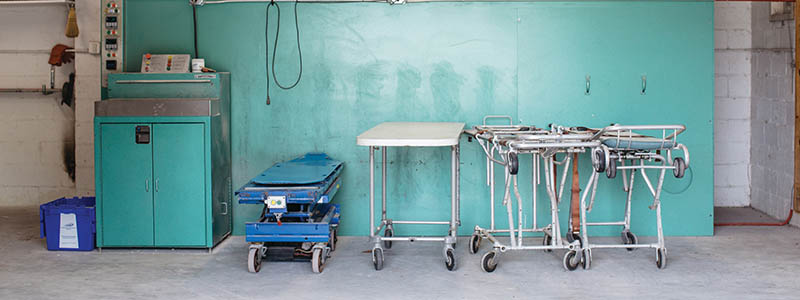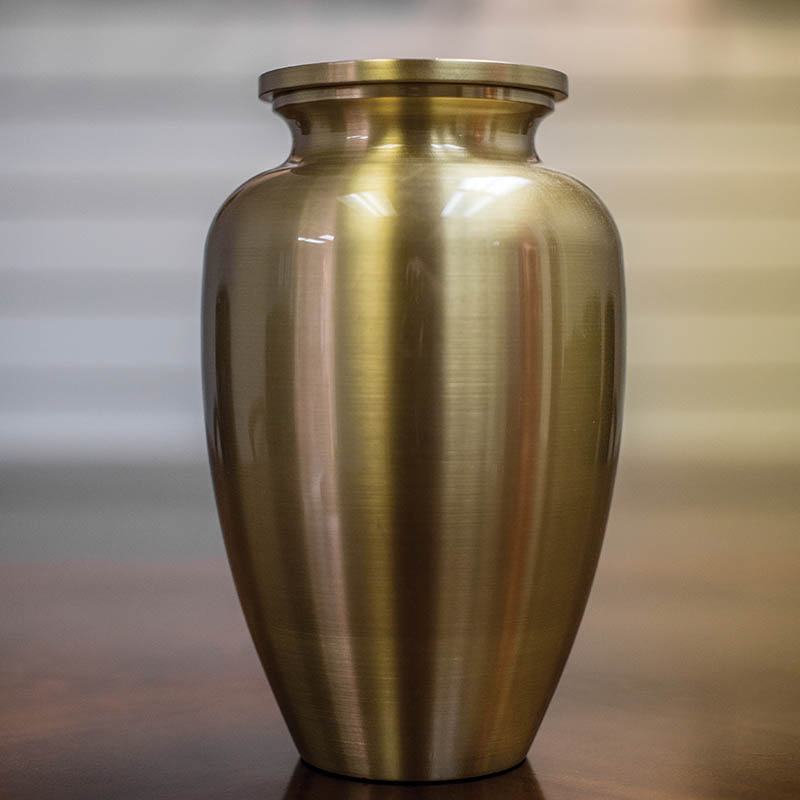Thick black smoke
The business of burning bodies at Kennedy-Midtown
Photos by Hans Kleinschmidt
The lobby of Kennedy-Midtown Funeral and Cremation feels like any other funeral home: Soft piano music playing, lights dimmed, the carpet a deep shade of red. Everything is clean, neatly arranged, and Kleenex boxes are plenty.
Beside a display of urns I met Lindsay Hart, mortician and funeral director of Kennedy-Midtown Funeral & Cremation. She was friendly and professional as she explained the business of cremation with a Midwestern tinge.
I followed her down a hall and to the garage, which is deep, wide, and painted white. Shelves line one wall. This is where the cremations are performed. American flags, wrapped in plastic, hang from a rack. The cremator is in the corner, where its flume extends into the ceiling. The bone grinder, called a cremulator, rests directly across from a large walk-in fridge. Cremulators are roughly the size of a dishwasher with a control panel and sorting tray on top, a black hole where the bones are inserted, and a chute on the side from which cremains are ejected. Adjacent to that is the door to the embalming room.
 Hart pressed a button and with a dull mechanical sound the door to the cremator opened. Also known as a retort chamber, it’s about the size of a sofa. During a body’s disintegration, the chamber reaches nearly 1,800 degrees Fahrenheit.
Hart pressed a button and with a dull mechanical sound the door to the cremator opened. Also known as a retort chamber, it’s about the size of a sofa. During a body’s disintegration, the chamber reaches nearly 1,800 degrees Fahrenheit.
“It’s about 60 minutes per 100 pounds,” Hart said. “Then we take the bones and put them in a processor. It sort of breaks down the bones, so it’s bones instead of ash—it’s not light like you see in the movies where you throw it and it blows in the wind, if you opened up an urn it would fall straight down on the ground like gravel—it’s heavy, dense as bone.”
Inside the machine, the retort’s refractory bricks looked clean, but darkened from years of use.
After a body combusts, vaporizes, oxidizes, and cools, the chamber is opened and the cremains are raked into a tray with a long hoe-like instrument. The chamber is scraped and cleaned with a wire brush until even the granules of bones are collected.
The cremains are then transferred into what looks like an archeologist’s tray. Metal odds and ends are sorted out—rivets or buttons from clothes, implants like fake knees and hips, small debris like medical screws, or braces and body jewelry—and put into a plastic bin to be taken away and recycled. I looked down into the recycling bin beside the cremulator. It sat half-empty, with a few pieces inside—mostly fake joints.
The remaining bone fragments are then placed in the cremulator, described to me at different times as akin to a large blender, food processor, and coffee grinder. On average, an adult female becomes 4 pounds of cremains, while a male yields 6 pounds. The cremulator takes around 20 minutes to pulverize the bones to a sand- or gravel-like texture. From there, cremains are placed in a temporary, state-mandated urn, which Hart said is essentially a “really thick plastic bag that you zip-tie shut and place in a lock-top black box.”

My uncle passed away July 20 this year. One week later, while going through his belongings with my family, I saw his urn on the countertop. It was made of plastic—faux pink marble. There was a sticker with his name above a photo of him smiling, his face illuminated. I looked inside the urn at his cremains with one of his brothers and we touched the tag that accompanies the body throughout the process.
“Everybody’s is different,” she said, smiling. “Some bones are white like Destin Beach sand. Some of them are darker. Some of them have bright, pretty turquoise in them. There’s coral. It’s really interesting.”
What to do with the cremains is left up to the deceased’s family. Some are buried in cemetery plots or interred in vaults, some are kept in homes or divided among the surviving family members, others are scattered. (I once took part in a ceremony where cremains were loaded into cartridges and fired from guns; I could taste it in the air after shooting.) Before a family, or one’s final testament, dictates what will be done with cremains, Kennedy assists with everything in between.
“It’s pretty straightforward. There’s not much preplanning in a cremation,” said Hart, who also offers families traditional funerary and burial services and who helps juggle business between Kennedy’s Midtown, Catoosa, and Broken Arrow locations.
“We go pick them up where they pass and we apply for a permit from the Oklahoma Medical Examiner Office. It takes 24 to 48 hours, and then we put them in the crematorium.”
The Oklahoma Office of the Chief Medical Examiner has seen a steady rise of cremation permits passing from their Tulsa office. A spokesperson gave these permit numbers over the past few years: 6,415 in 2014, 6,742 in 2015, 7,248 in 2016, and 5,223 to date on September 14, 2017.
From 2004–2014, the National Funeral Directors Association reported a 26 percent increase in the cost of burials and viewings. The number of cremations surpassed burials for the first time in 2015.
The 2017 projection for cremation versus burial rate is 51.6 and 42.4 percent, and the 2030 projection is 71.1 and 23.2 percent. The NDFA figures the median cost of an adult funeral with viewing and burial was $7,181 in 2014, while the median price for a funeral with viewing and cremation was $6,078 the same year.
 Most crematoriums are able to financially assist those in need. The price of Kennedy’s cremations average around $3,000, though they’ll charge less for those who are unable to afford standard pricing. Around 85–90 percent of Hart’s customers now choose cremation over burial, and Kennedy handles 40–50 deaths a month.
Most crematoriums are able to financially assist those in need. The price of Kennedy’s cremations average around $3,000, though they’ll charge less for those who are unable to afford standard pricing. Around 85–90 percent of Hart’s customers now choose cremation over burial, and Kennedy handles 40–50 deaths a month.
“With younger generations there’s a lot of people like, ‘Just put me in a tin can, whatever you guys need,’ which I think is important … for the people that you leave behind, what they need and what they want,” Hart said.
Hart said funeral and cremation businesses can opt in or out of being on the City of Tulsa’s DOA rotation.
“Those are the homeless, the indigent, and the no family, unclaimed bodies. Every week it’s a different funeral home, if you decide you want to be involved in that, which we do. So, if that’s the situation, we pick them up and we apply through Tulsa County Social Services, if they passed in Tulsa … We try to put it in the paper, and once in a while someone will call, finding their loved one.”
Hundreds of unclaimed remains are stored at their Broken Arrow facility, sorted by year. Sometimes it’s too difficult for a family to claim their loved one’s remains right away, and Kennedy has no issue with storing them until the family is ready.
I asked Hart about the smoke and flames I see north of Interstate 244 some mornings on my commute.
“When they’re large, those flames are fat because it’s essentially like a grease fire … It’s like 10 feet high, people see it on
[I-]244 and go, ‘Dear God, there’s a fire!’”
Someone at Kennedy usually calls the fire department before a burning, because Tulsa Fire Department receives calls about the smoke and flames.
“It’s just one person at a time,” Hart said, unprompted. “Even still, I think people maybe have misconceptions that we’re just throwing piles of bodies in there, or whatever … Within the crematorium it doesn’t blow around. When you place a body in like that”—she gestured with her hand, mimicking rigor mortis—“and you open the door, the skeleton is lying exactly the way you put it in there, so it’s not just a pile of ash like people think. To say there’s a little particle getting mixed in here and there, sure, I’m sure there is, but 99 percent of it is your loved one.”
I replaced the metal lid on the cremulator and wiped dust off my hands.
Our last stop was a light-pink, brightly lit embalming room that smelled like sickly sweet chemicals. A young black man was lying on a white embalming table with a sheet covering him waist-down.
Cabinets holding the embalming chemicals hung above a sink. A mop bucket was in the corner, and brooms hung on the wall. The floor was red, almost the shade of the lobby’s carpet. Two machines for draining fluids from bodies sat at the head of each table.
I looked at the young dead man, soon to be placed in the cremator. Part of him will remain here and part of him will rise above Tulsa—a thick black smoke that gradually grows grey, then white, then dissipates into the air.


.jpg)
.jpg)
